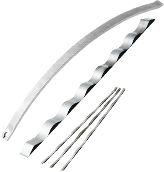- keyword
- compressionsprings
- hysteresis
- discsprings
Question Guowang 2004/12/10(Fri) 12:30
I was finding information about the hysteresis of the compression spring and happened to arrive here.
I would like to ask you a question. In the case of disc spring, a hysteresis phenomenon occurs when the load characteristic differs (in which the pressure is applied and reduced). Do the compression springs have this characteristic? If they do, in which case will it happen?
Answer Tokai Spring 2004/12/13(Mon) 18:50
Hysteresis does not happen to compression coil springs, but it does happen to torsion coil springs. When the coil part is wound closely, a close contact force is generated between the coils as with the initial tension of the tension coil spring, and a frictional force between the coils is generated. This causes hysteresis during operation.
To prevent this, it is good to provide a slight gap between the coils.
Answer Faris ARSLAN 2020/12/7(Mon) 1:09
Dear Sir!.. I want to ask a question.
As known, a certain amount of energy is applied for compressing a mechanical spring. Thus mechanical spring is charged with energy and it stores it as elastic-potential energy. But whole energy, applied for compressing spring, can not be converted into potential energy. The reason is the internal friction of spring which causes heat loss during the compressing process. Thus some energy is wasted as heat and retain energy is stored as elastic potential energy. If we assume:
Applied Energy for compressing=Eapp
Wasted Energy due to heat loss=Ewast
Stored Elasto-potential Energy =Epot
We can formulate Stored Elasto-potential Energy as:
Epot = Eapp – Ewast
So what is the Ewast / Eapp ratio? In other words, what is the approximate Energy loss percentage for springs made of steel? And can u suggest to me any source as website, book, etc..
Answer Tokai Spring 2020/12/7(Mon) 19:09
In a compression coil spring, the friction of the active part that acts as a spring is extremely small, and therefore almost no energy loss occurs.
Therefore, the energy loss due to friction can be considered zero.
As you said, when friction occurs in the active part such as in torsion coil springs, part of the energy is converted into heat energy, causing energy loss.
However, it is quite impossible to clearly calculate the loss rate of this heat energy. Also, because it is extremely difficult, we also couldn’t find any materials.
This is because the frictional force changes not only due to the shapes and surface conditions of the springs but also on the producing process of different manufacturers.
In the case of metal springs, if the compressive load and torsional torque can be measured, the ratio of energy loss due to friction can be confirmed.
We are happy to answer any inquiries regarding technology, specifications, materials, etc. Please feel free to ask.

















